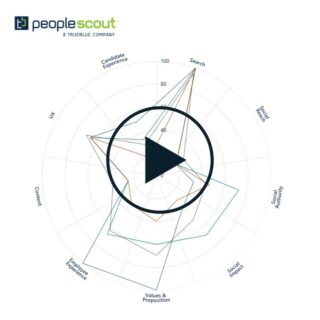The talent acquisition landscape is undergoing a radical transformation. While artificial intelligence has been steadily entering the recruitment space for years, we’re now witnessing an unprecedented acceleration that’s redefining what’s possible. The statistics tell a compelling story: 75% of global knowledge workers now use Generative AI (Gen AI), with adoption nearly doubling in just six months. Yet only one in ten organizations have comprehensive strategies in place for AI integration.
This gap between adoption and strategic implementation represents both a challenge and an opportunity for forward-thinking talent acquisition teams. Most organizations are still just scratching the surface of potential of AI for recruiting, with 60% using AI merely for résumé screening and only 7% leveraging it for advanced analytics. The result? A significant competitive advantage awaits those who can move beyond basic automation to true intelligence.
Traditional recruiting technologies have served us well in streamlining workflows, but they often fail to address the core challenges of modern talent acquisition: identifying potential beyond credentials, predicting candidate success, scaling personalized experiences and making confident decisions in volatile labor markets.
The next generation of AI in talent acquisition represents a fundamental shift from rules-based automation to learning systems that improve over time. While there is no “all-in-one” AI solution on the market, four key technologies are driving this transformation:
Natural Language Processing (NLP)
Natural Language Processing (NLP) is a branch of AI that enables computers to understand, interpret and generate human language. NLP has observed tremendous growth and innovation this year which can largely be attributed to breakthroughs in deep learning, especially the more advanced Large Language Models (LLMs). NLP can be used for tasks such as translating languages, summarizing texts, analyzing sentiments and even automating interactions.
In talent acquisition, NLP powers numerous applications:
- Résumé Parsing: Automatically extracting relevant information from résumés and CVs to streamline candidate evaluation.
- Automated Screening: Using text-based screening questions to qualify candidates based on essential criteria and analyzing their responses.
- Chatbots for Candidate Engagement: Providing real-time responses to candidate inquiries, guiding them through the application process, and enhancing their experience.
- Interview Transcription and Analysis: Transcribing live or recorded interviews and analyzing the content for key insights.
- Diversity and Inclusion Monitoring: Analyzing language used in job descriptions and recruitment communications to reduce bias and ensure inclusivity.
- Personalized Communication: Customizing messages to include candidate names and specific role details, increasing engagement and reducing fallout.
Machine Learning
Machine learning (ML) is a subfield of AI that enables computers to learn and make decisions from data without being explicitly programmed. Algorithms identify patterns and insights in large sets of data, which are used to make predictions and improve processes over time. Essentially, it’s like teaching a computer to recognize trends and make smart choices based on past information.
ML systems transform talent acquisition through:
- Candidate Sourcing and Matching: Leveraging precision algorithms to identify the best candidates from millions of profiles, including those likely to leave their current positions.
- Performance Metrics: Using data insights to track and improve recruiter and hiring manager performance.
- Diversity and Inclusion: Analyzing diversity metrics to support inclusive hiring initiatives.
- Adaptive Learning: Continuously improving the accuracy of sourcing and recommendations by learning from recruiter interactions.
- Trend Analysis: Identifying areas of success and opportunities for improvement through visual trend analysis.
Predictive Analytics
Predictive analytics use machine learning models to analyze historical data and make predictions about future events—forecasting trends, behaviors and outcomes. For example, in recruitment, predictive analytics can use ML models to predict future hiring needs based on past trends.
Use cases for Predictive Analytics in talent acquisition include:
- Forecasting Future Hiring Needs: Predicting future recruitment demands based on historical data and trends.
- Optimizing Sourcing Channels: Identifying which recruitment sources yield the best candidates and maximize ROI to allocate resources effectively.
- Mitigating Turnover Risks: Identifying candidates more likely to leave their positions and prioritizing engagement with stable candidates.
- Enhancing Candidate Experience: Predicting and addressing bottlenecks in the recruitment process to improve candidate progression and satisfaction.
Agentic AI
Incorporating advanced technologies like machine learning and predictive analytics, Agentic AI systems are designed to act autonomously to achieve specific goals, executing multi-step processes without continuous human intervention—unlike traditional pre-programmed chatbots. Agentic AI is the most cutting edge, and potentially overhyped, emerging technology we’ll cover here, with most AI agents today resembling RPA, rather than being truly agentic. However, Deloitte predicts 25% of enterprises using generative AI will deploy AI agents in 2025 (increasing to 50% by 2027).
In talent acquisition, Agentic AI can support:
- Recruiter Efficiency: Acting as proactive partners for recruiters by surfacing critical insights, predicting candidate behavior and identifying trends—allowing human professionals to focus on relationship building and complex negotiations.
- Dynamic Personalization: Autonomously tailoring content and communications to each candidate based on their browsing behavior, past interactions and career interests.
- Proactive Engagement: Anticipating needs and independently initiating relevant support by analyzing candidate data and behavior patterns.
- Advanced Question Handling: Managing FAQs and knowledge bases across multiple databases while continuously learning from interactions.
- Candidate Need Anticipation: Predicting trends and identifying candidates at risk of dropping out, even independently placing them into re-engagement campaigns.
- Cohesive Multichannel Experiences: Integrating data across all channels to create a complete candidate view and ensure conversation continuity across platforms.
Preparing for the AI-Augmented Future
As these technologies reshape talent acquisition, organizations must prepare strategically to harness their full potential. This preparation extends beyond technological implementation to encompass three critical dimensions:
- The role of recruiters is evolving from process facilitators to strategic talent advisors. AI automates administrative tasks, freeing human professionals to focus on relationship building, understanding candidate motivations and serving as authentic employer brand ambassadors. This transition requires significant investment in upskilling.
- Ethical considerations should be central to your strategy. As AI becomes more deeply embedded in recruitment processes, organizations must commit to responsible usage through rigorous auditing, fairness protocols and transparency with candidates about AI’s role in the hiring process.
- The human element remains irreplaceable in recruitment, with technology serving to enhance rather than eliminate these essential human capabilities. The most successful organizations will be those that leverage AI to amplify human strengths—empathy, intuition, relationship building and complex decision-making—while automating repetitive tasks. This symbiotic relationship between human expertise and technological capability creates a recruiting function that is both more efficient and more effective at identifying, engaging and securing top talent.
The future of talent acquisition belongs to those who can move beyond basic automation to embrace truly intelligent systems that enhance human capabilities. By understanding and strategically implementing these four cutting-edge technologies, organizations can position themselves at the forefront of recruitment innovation for years to come.
Ready for what AI will bring to the future of recruitment? Download our comprehensive ebook to discover how emerging technologies can give you a competitive advantage.



